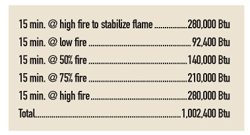
Photo credit: Ray Wohlfarth

Fuel Consumption Chart
So, when is the best time to perform the combustion analysis? Like almost every question asked in this industry, the answer is, “It depends.” Consider the advantages and disadvantages of each so that you may decide which is better for you.
Combustion efficiency of a boiler is a measurement of how much heat is transferred from the flame into the heating medium, such as water or steam, and how much is lost up the stack. Traditional boilers are usually between 70 to 85% efficient. Condensing boilers can be as high as 99% efficient. Combustion efficiency testing will show what the ratio of air to fuel is during the burn cycle.
For instance, a boiler that burns natural gas will require about 10 cubic feet of air for every cubic foot of gas for perfect combustion efficiency. In No. 2 fuel-oil burners, the burner requires about 14 pounds of air for every pound of fuel oil for perfect efficiency. Extra or excess air is added to the flame to assure safe operation and to protect the boiler from sooting. Sooting occurs if there is insufficient air or incomplete combustion for the burner. Oxygen content for the combustion air can vary greatly by combustion air temperature and/or barometric conditions.
When adjusting the fuel-to-air ratio, it is common practice to operate the burner for 15 minutes to allow the flame and draft to stabilize. An on-off burner will require about 10 to 15 minutes to adjust the combustion efficiency after the initial 15 minutes. A low-high-low burner will require about 20 to 30 minutes to adjust. And a fully modulating burner will take about an hour to properly adjust.
If you add the 15 minutes it takes for the flame to stabilize, the combustion analysis and adjustment will take about 30 minutes for an on-off burner and 75 minutes for a modulating burner.

Chart 2
Fall or winter testing
Let us consider a hypothetical building that is roughly 50,000 square feet. At design temperature, our building will lose 1.5 million Btu per hour or 25,000 Btu per minute. Our heating plant will consist of two hydronic boilers with fully modulating burners. Each boiler will be 80% efficient and sized to provide 75% of the heating requirements of the building at design temperature.The boilers will have rated inputs of 1.4 million Btu/hr. and an output of 1.12 million Btu/hr. The table on page 56 shows the consumption of fuel per minute per boiler at the most common firing rates.
The following is a demonstration of a pre-season combustion analysis and adjustment. We visit the jobsite on a fall day when the outside temperature is about 50˚ F. At this temperature, our building will lose 346,154 Btu per hour, or about 5,769 Btu per minute. This is about 23% of our design heat loss. The building hydronic loop temperature will be about 130˚ at this outside temperature and will contain about 1.86 million Btu.
We start our first boiler and allow it to operate at high fire for 15 minutes to stabilize the flame. We then begin our adjustment of the fuel to air. Let us assume it takes us about 15 minutes to adjust the fuel-to-air ratio at each of the firing rate positions: low fire, 50% fire, 75% fire, and high fire. At the end of the hour, we would have added the following Btu into the building:
At the completion of our adjustment of the first boiler, our building’s hydronic-heating loop has gone from 1.86 million Btu with an average temperature of 130˚ to a loop that contains 2.87 million Btu with an average temperature of about 200˚. If we are lucky, we would have completed the adjustment before the boiler shut off on the operating or limit control.
Our next challenge is to adjust the second boiler. It will take 2.89 hours for the building to lose enough heat to lower the loop temperature to the original starting point.
Consider what happens when you perform the combustion analysis in the middle of winter. If we perform our adjustments when the outside temperature is at 12˚, the building will lose 1.27 million Btu/hr., or 21,154 Btu per minute. It will take about 47 minutes for the building to lose the amount of heat we added to the loop. This is about a third of the time it took at a 50˚ outside temperature. This analysis is more efficient.
For my commercial customers, I like to perform the combustion analysis and adjustment in the winter when the building is under a heavy load. During the pre-season inspection, I perform a cursory check to make sure the fuel-to-air adjustment is close.


